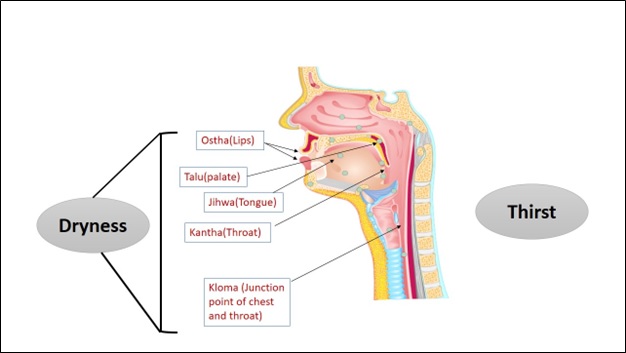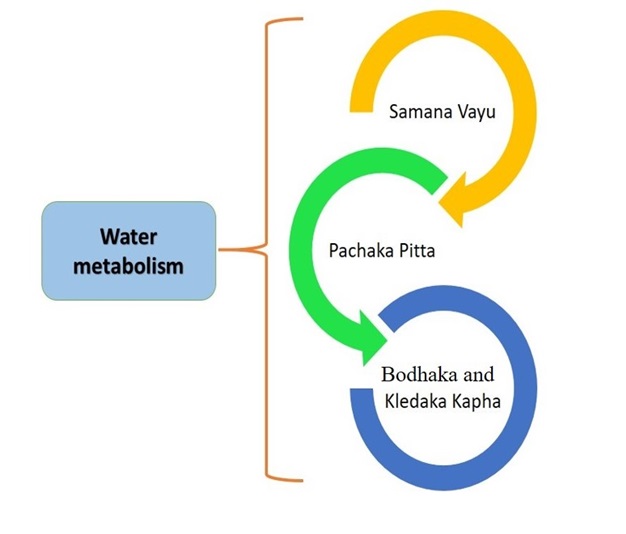Difference between revisions of "Talk:Udakavaha Srotas"
Manishdubey (talk | contribs) |
Manishdubey (talk | contribs) |
||
| Line 45: | Line 45: | ||
<br/>'''Srotas:''' ambusarana,svatasan, [4]sira, dhamani, rasayani, rasavahini, nadi, pantha, marga, sharirachhidra, samritasavritta, Sthana, ashaya, niketa[Cha. Sa. Vimana Sthana 05/09], yogvahi[5] [Su. Sa. Sharira Sthana 05/05], a wave, the flow, a current, the canal of nutrients in the body.[6] | <br/>'''Srotas:''' ambusarana,svatasan, [4]sira, dhamani, rasayani, rasavahini, nadi, pantha, marga, sharirachhidra, samritasavritta, Sthana, ashaya, niketa[Cha. Sa. Vimana Sthana 05/09], yogvahi[5] [Su. Sa. Sharira Sthana 05/05], a wave, the flow, a current, the canal of nutrients in the body.[6] | ||
<br/>'''Udakavaha srotas:''' ambuvaha[Cha. Sa. Vimana Sthana 05/9] [Cha. Sa. Chikitsa Sthana 28/8], rasavahini [Cha. Sa. Chikitsa Sthana 22/06], water regulating system. | <br/>'''Udakavaha srotas:''' ambuvaha[Cha. Sa. Vimana Sthana 05/9] [Cha. Sa. Chikitsa Sthana 28/8], rasavahini [Cha. Sa. Chikitsa Sthana 22/06], water regulating system. | ||
| + | |||
| + | ==Origin (Srotomula)== | ||
| + | <p style="text-align:justify;"> Acharya described the two roots of every srotas. In context of udakavaha srotas, the roots are palate (talu) and junction of throat & chest (kloma). [Cha. Sa. Vimana Sthana 05/09] [Su. Sa. Sharira Sthana 09/12] [5]Acharya described these sites as root because in water imbalance, these organs first manifest the sign of thirst. The exact site of kloma is not defined but it’s the main controlling center for water regulation in the body. Acharya chakrapani described kloma as the site of thirst and mentioned that it is situated near the heart (hridyastha pipasa sthana).[Chakrapani on Cha. Sa. Vimana Sthana 05/08] Acharya Gangadhara described the site of kloma as the junction of throat and chest (Kantha urso sandhi). [Gangadhara on Cha. Sa. Vimana Sthana 05/08] | ||
| + | The name "kloma" can be applied to mediastinum that is located at above mentioned sites. [7] | ||
| + | Contemporary understanding of regulation of water is a feedback process involving the hypothalamus, the neurohypophysis, and the kidneys.[8] The main hormone that controls how much water the body retains is arginine vasopressin (AVP), commonly known as anti-diuretic hormone.[9] | ||
| + | </p> | ||
| + | |||
| + | <p style="text-align:justify;">'''Etiological factors behind srotas abnormalities (sroto dushti hetu)'''</p> | ||
| + | [Cha. Sa. Vimana Sthana 05/11]These factors are: | ||
| + | 1. Intake of hot food (aushnyat) | ||
| + | 2. Indigestion (aamat) | ||
| + | 3. Fear (bhayat) | ||
| + | 4. Excessive intake of alcohol (panat) | ||
| + | 5. Intake of excessive dry food article (arishuksha anna sevanat) | ||
| + | 6. Habit of withholding the urge in excessive thirst (trishnaya cha atipidanat) | ||
| + | All these factors contributed in dysregulation of water regulation. | ||
| + | |||
| + | |||
| + | |||
| + | |||
| + | |||
| + | |||
| + | |||
| + | |||
| + | |||
| + | |||
| + | |||
| + | |||
| + | |||
| + | |||
| + | |||
| + | |||
| + | |||
[[File:Figure 02- Udakavaha srotodushti lakshana..jpg|center]] | [[File:Figure 02- Udakavaha srotodushti lakshana..jpg|center]] | ||
<center>'''Figure 02: Udakavaha srotodushti lakshana'''</center> | <center>'''Figure 02: Udakavaha srotodushti lakshana'''</center> | ||
| Line 51: | Line 84: | ||
[[File:Dosha helpful in water metabolism.jpg|center|Figure 03: Dosha helpful in water metabolism.]] | [[File:Dosha helpful in water metabolism.jpg|center|Figure 03: Dosha helpful in water metabolism.]] | ||
| + | |||
| + | |||
Revision as of 06:18, 10 October 2023
Udaka means water. In body, water is present in the form of various fluids. Udakavaha srotasa are the channels for transport and transformation of fluid (water) and its circulation. They are the pathways that originate from the palate (talu) or kloma (an internal organ controlling thirst) through which fluids circulate throughout the body. [Code:SAT-B.475][1]A water-based solution of ions and other compounds makes up most of the adult human body's 60% fluid content. Water makes up most of a cell's primary fluid medium except fat cells. It is present in most cells at a concentration of between 70 and 85 percent.[2] The human body uses water as a construction material, a lubricant, a shock absorber, a solvent, a reaction medium, and a reactant. It also serves as a transporter for nutrients and waste products. Water balance must be managed for the preservation of health and life.[3] So udakavaha srotas are the channels for regulating the water homeostasis in the human body, and failure to do the same can lead to death. This article deals with physiological, pathological and therapeutic aspects of udakavaha srotasa.
| Section/Chapter/topic | Concepts/SrotasUdakavaha Srotas |
|---|---|
| Authors | Bhojani M. K. 1, Tanwar Ankur Kumar 1 |
| Editor | Deole Y.S.3 |
| Affiliations |
1 Department of Sharir Kriya, All India Institute of Ayurveda, New Delhi, India 2 Rheumatologist, Orlando, Florida, U.S.A. 3 Department of Kayachikitsa, G. J. Patel Institute of Ayurvedic Studies and Research, New Vallabh Vidyanagar, Gujarat, India |
| Correspondence emails |
meera.samhita@aiia.gov.in, carakasamhita@gmail.com |
| Publisher | Charak Samhita Research, Training and Development Centre, I.T.R.A., Jamnagar, India |
| Date of publication: | October 10, 2023 |
| DOI | -- |
Etymology and derivation:
The word udaka is derived from root “undi kledane”.[4] It implies that thing which is to wet is udaka.
The word srotas is derived from Sanskrit root “sru”.[4] Meaing of sru is to secrete, to flow. Acharya sushruta defines srotas as tubular structures through which fluid material circulates in the body.[5] [Su. Sa. Sharira Sthana 09/13] Dalhana mentioned two important characteristics of srotas: 1. Passage for fluid (abhivahanshila) and 2. Hollow space to flow (avakash).[5] [Dalhan on Su. Sa. ShariraSthana 09/13] Srotas, according to acharya Charak, is a structure through which anything is conveyed or flows. [Cha. Sa. Sutra Sthana 30/12] Udakavaha srotas are the channels for water regulation.
Synonyms:
Udaka: apa, vari, salil, kamal, jalam, payas, water. [4][6]
Srotas: ambusarana,svatasan, [4]sira, dhamani, rasayani, rasavahini, nadi, pantha, marga, sharirachhidra, samritasavritta, Sthana, ashaya, niketa[Cha. Sa. Vimana Sthana 05/09], yogvahi[5] [Su. Sa. Sharira Sthana 05/05], a wave, the flow, a current, the canal of nutrients in the body.[6]
Udakavaha srotas: ambuvaha[Cha. Sa. Vimana Sthana 05/9] [Cha. Sa. Chikitsa Sthana 28/8], rasavahini [Cha. Sa. Chikitsa Sthana 22/06], water regulating system.
Origin (Srotomula)
Acharya described the two roots of every srotas. In context of udakavaha srotas, the roots are palate (talu) and junction of throat & chest (kloma). [Cha. Sa. Vimana Sthana 05/09] [Su. Sa. Sharira Sthana 09/12] [5]Acharya described these sites as root because in water imbalance, these organs first manifest the sign of thirst. The exact site of kloma is not defined but it’s the main controlling center for water regulation in the body. Acharya chakrapani described kloma as the site of thirst and mentioned that it is situated near the heart (hridyastha pipasa sthana).[Chakrapani on Cha. Sa. Vimana Sthana 05/08] Acharya Gangadhara described the site of kloma as the junction of throat and chest (Kantha urso sandhi). [Gangadhara on Cha. Sa. Vimana Sthana 05/08] The name "kloma" can be applied to mediastinum that is located at above mentioned sites. [7] Contemporary understanding of regulation of water is a feedback process involving the hypothalamus, the neurohypophysis, and the kidneys.[8] The main hormone that controls how much water the body retains is arginine vasopressin (AVP), commonly known as anti-diuretic hormone.[9]
Etiological factors behind srotas abnormalities (sroto dushti hetu)
[Cha. Sa. Vimana Sthana 05/11]These factors are: 1. Intake of hot food (aushnyat) 2. Indigestion (aamat) 3. Fear (bhayat) 4. Excessive intake of alcohol (panat) 5. Intake of excessive dry food article (arishuksha anna sevanat) 6. Habit of withholding the urge in excessive thirst (trishnaya cha atipidanat) All these factors contributed in dysregulation of water regulation.
Send us your suggestions and feedback on this page.

